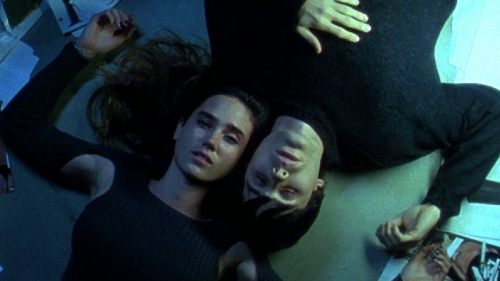REQUIEM FOR A DREAM: Darren Aronofsky’s First Horror Film
mother! opens this week. Get your tickets here!
“Trust me, it’s a horror film.”
So said makeup effects artist Vincent Guastini when he told me I should come down to the set of the latest film he was working on, Darren Aronofsky’s Requiem for a Dream, back during my Fangoria days. It was certainly an intriguing project: the second film from the director who had grabbed everyone’s attention with the microbudget science-fiction opus π, working with name actors for the first time, including Jared Leto, Jennifer Connelly, Marlon Wayans and the legendary Ellen Burstyn. But from everything I’d heard…wasn’t this a drama about drug addiction?
It was, Vincent said, but it was also a genre film, and when I went down to the lower-Manhattan restaurant location to check out one of his effects in action, Aronofsky confirmed it: Requiem for a Dream was a horror movie, and addiction was the monster. “I call it a hyper-real freefall into the deepest recesses of the human psyche,” he told me on that set. “It’s about four characters who totally take a descent into hell, and the hell they visit is that of their own minds. In many ways, it’s structured very much like a horror film—but unlike most monster movies and most Hollywood films, instead of the human spirit winning, addiction wins.”
Aronofsky had, in fact, been previously set to follow up π with the supernatural submarine thriller Below for Dimension Films, but that one had fallen through (David Twohy eventually took it on, though Aronofsky retains a screenwriting credit), leading him to instead adapt Requiem from the acclaimed novel by Hubert Selby Jr. “He was always sort of a god in my life,” Aronofsky said, “and Requiem is a nice stepping stone before I go into bigger science fiction films and thrillers. I thought it would allow me to explore certain themes in a more complex way than I was able to explore them in π.”
He certainly succeeded. Although Requiem functions as an intensely dramatic account of four lives collapsing under the weight of various monkeys on their backs, it is as disturbing and visceral as any traditional fright feature. To the latter end, Guastini’s makeup illusions range from Connelly’s Marion stabbing the hand of a sleazy shrink (played by π’s Sean Gullette) with a fork—the gag I witnessed during my visit—to Harry (Leto) having his arm surgically severed to Burstyn’s Sara withering away from her dependence on diet pills. Just as disturbing as these ghastly visuals is the degradation of the human spirit as uncontrolled substances take over their lives.
“When I was structuring the film and looking at the four characters [also including Wayans’ Tyrone] and their arcs over the course of the story,” Aronofsky said, “I realized that when anything positive seemed like it was going to happen to them, something negative actually did. And then I flipped it over and realized that there was one character for whom positive things were happening throughout, every moment, and that character was addiction. And every time something bad happened to one of those people, addiction was winning. It was then that I realized I was making a film about a monster.”
One of Requiem’s achievements is that Aronofsky successfully pulls off a tonal balance between down-and-dirty realism and horrific flights of fantasy and surrealism, building on the aesthetic he first adopted with π. Compared to that film, he said on the Requiem set, “There’s a more realistic story going on here, but the way we’re telling it visually and soundwise is equally pushing the envelope. My taste is very sci-fi. It’s what I grew up on, things like Planet of the Apes and The Twilight Zone and The Six Million Dollar Man. I always liked those series, and when I go to see a movie, I’m not much into realism at all. I mean, I respect John Cassavetes, and directors like him and their work, but I’m not really a viewer of them. I’ve always enjoyed films that delve into fantasy much more, and I believe those genres allow you to leave tradition behind and let the imagination run. That’s what I love about them.”
Since Requiem propelled him further into the limelight, Aronofsky has been attached to numerous screen projects based on existing properties: a film of Frank Miller’s Ronin, the RoboCop remake, and a Wolverine movie. Yet he wound up instead seeing largely original projects through to fruition, like the heady sci-fi trip The Fountain, the gritty, sweaty underdog drama The Wrestler and the ballet psychodrama Black Swan, plus his unique take on the Biblical saga with Noah. Now, with mother!, he has made his most explicitly horrific movie since Requiem, one that carries over the echoes of early Roman Polanski thrillers also seen in Swan. And in fact, Aronofsky told me when I interviewed him about Swan, Polanski’s early, disquieting cinema has long been one of his touchstones. “I’ve been a big fan of his for a very long time,” he said. “He was a major influence as far back as π, and he continues to be an inspiration.”


_500_281_81_s_c1.jpg)
